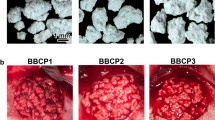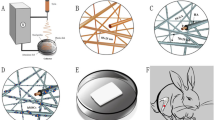Abstract
The purpose of this study was to examine the repairing ability of nano-hydroxyapatite (nano-HA) artificial bone with different pore sizes. Animal models of bone defects were created in both radii of 60 New Zealand white rabbits. The bone defects in A, B, and C groups were repaired with nano-HA artificial bone with three different pore sizes while those in group D were left unrepaired. The repairing ability of material was evaluated by gross observation, histopathological study, X-ray examination, scanning electron microscope (SEM), and biomechanical analysis in the fourth, eighth, and 12th weeks. Group B stimulated more bone formation than the other groups. Nano-HA artificial bone is capable of good bone formation and biocompatibility. The ability of bone formation of nano-HA artificial bone may be affected significantly by the pore size. The material with pore size in the range of 100 –250 μm has a greater ability to form bone.
Résumé
L’objectif de cette étude est d’étudier les possibilités de réparation osseuse avec la nano-hydroxyapatite (nano-HA) sur des os artificiels avec différentes tailles de pores osseux. Méthode : le modèle animal choisi l’a été avec constitution d’un défect osseux au niveau du radius bilatéral de 60 lapins blancs de Nouvelle Zélande. Les défects osseux ont été réalisés sur trois groupes A, B et C avec réparation par nano-hydroxyapatite et trois calibrages différents et un dernier groupe D sans mise en place de nano-hydroxyapatite. Les possibilités de réparation ont été évaluées par l’observation macroscopique des études histopathologiques, des études radiologiques, le microscope électronique, l’étude biomécanique. Toutes ces études ont été réalisées à 4, 8 et 12 semaines. Résultats, le groupe B permet une cicatrisation osseuse plus importante que dans les autres groupes. En conclusion : l’os artificiel constitué par la nano-hydroxyapatite permet une bonne régénération osseuse et cette régénération est influencée par la taille des pores osseux. Le matériel avec des pores compris entre 100 et 250 Im est la dimension optimum pour permettre cette régénération.





Similar content being viewed by others
References
Chang BS, Lee CK, Hong KS et al (2000) Osteoconduction at porous HA with various pore configurations. Biomaterials 20:1291–1295
Dorner-Reisel A, Klenn V, Irmer G et al (2002) Nano and microstructure of short fibre reinforced and unreinforced hydroxyaptite. Biomed Tech 47(suppl 1Pt1):397–400
Ei GH, Annam A, Ducheyne P et al (1995) Reconstruction of alveolar bone defect by calcium phosphate compounds. Biomed Mater Res 29(3):359–370
Jiang HP, Wang DP, Ruan JM, Zhu WM (2005) Biocompatibility study of nano-hydroxyapatite artificial bone. China J Modern Medicine 6(10):24–29
Jouve JL, Mottet V, Cottalorda J et al (1998) Reimplantation of growth plate chondrocyte cultures in central growth plate defects: part 1. Characterization of cultures. J Pediatr Orthop B 7:167–173
Liu DM (1998) Preparation and characterization of porous hydroxya-patite bioceramicvia as lip-casting route. Ceram Int 24:441–445
Milosevski M, Bossert J, Milosevski D et al (1999) Preparation and properties of dense and porous calcium phosphate. Ceram Int 25:693–695
Ruan JM (2000) Chinese patent. Produce method of polyporous biomaterial. ZL 91106753.1
Wang D, Zheng CQ, Hu YY (1999) The new progress of biological material study. Biomed Engin For Med Sci 22(6):364–367
Yang ZJ, Yuan HP, Zhang XD et al (1996) Effect of sarsasapogenin and its derivatives on the stimulus coupled responses of human neutrophils. Biomaterials 17:2131–2137
Zhu WM, Wang DP, Meng ZB et al (2006) Experimental study of the nano-hydroxyapatite artificial bone in repairing the bone defect. Chinese J Clin Anat 6(10):13–18
Zhu WM, Wang DP, Xiong JY et al (2006) Revascularization study of the nano-hydroxyapatite artificial bone in repairing the bone defect. J Chinese Microcirculation 5(4):37–42
Zhu WM, Wang DP, Xiong JY (2007) Biological characteristics and clinical application of scaffold materials for bone tissue engineering. J Clin Rehab Tissue Eng Res 48:23–26
Author information
Authors and Affiliations
Corresponding author
Rights and permissions
About this article
Cite this article
Zhu, W., Xiao, J., Wang, D. et al. Experimental study of nano-HA artificial bone with different pore sizes for repairing the radial defect. International Orthopaedics (SICOT) 33, 567–571 (2009). https://doi.org/10.1007/s00264-008-0572-5
Received:
Revised:
Accepted:
Published:
Issue Date:
DOI: https://doi.org/10.1007/s00264-008-0572-5




